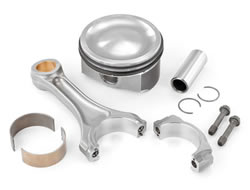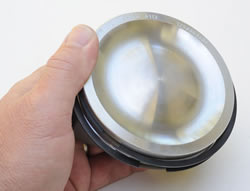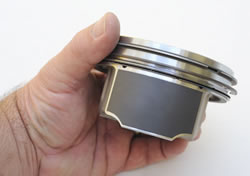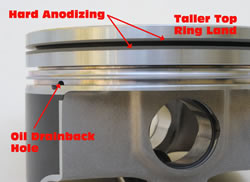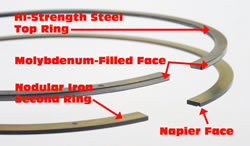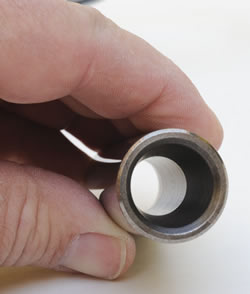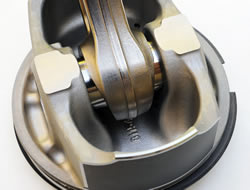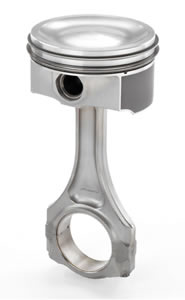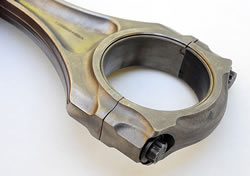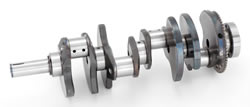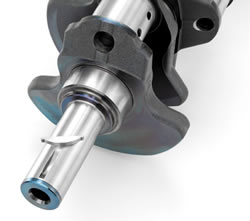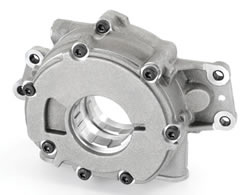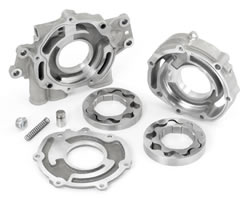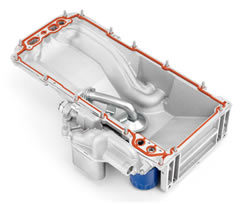2009 Corvette ZR1: Ruthless Pursuit of Power: Supercharged Edition - Page 5 of 7
 |
 |
Page 5 of 7
© 2008 by Hib Halverson
No use without permission, All Rights Reserved
![]() Discuss this article
Discuss this article
Rotating and Reciprocating Parts in the Bottom End
The parts inside the LS9 block which go round-and-round or back-and-forth are quite different than the same parts in an LS3. Due to the LS9's high combustion pressure—up to 11 megapascal (1600 psi) vs. 8 MPa (1160 psi) for the LS7—its pistons are made of forged, eutectic, rather than cast hypereutectic, S2N aluminum. They are the first, production Small-Block forged pistons since the 1970s and are made by Federal-Mogul.
While other Corvette engines have compression ratios as high as 11:1, the ZR1's engine is down at 9.1:1. A lower compression ratio is typical of supercharged engines which run on pump gasoline because at high load, the engine's cylinder pressure is much higher due to blower boost. If that was combined with high static compression ratio and the 91-93 octane fuel typically sold as "premium" or "super" unleaded gasoline, the engine would suffer excessive detonation. A near-two-point reduction in com-pression ratio is the solution. As the combustion chamber displacement is the same as LS3, a dished or "sunk dome" piston is required to accomplish that reduction. Even at 9.1:1, LS9 is one of the few GM engines which requires premium fuel. Further, it's calibrated for 93-octane gas, so those living in the Western U.S., where 93 is generally not available, may have to mix in a little 100-octane unleaded racing gas with the 91-octane fuel they usually find to get the engine's full performance in warm or hot weather.
Another difference in the LS9 piston is that the top ring land is wider, an upgrade required for "QRD" (quality/reliability/durability) at the 638-hp level. Specifically, the extra width prevents deflection of the top land. As the piston nears TDC on the compres-sion stroke, the spark comes, air-fuel charge starts burning and compression pressure builds behind the ring, pushing it hard against the cylinder wall. As the piston starts down on the power stroke, the ring with all that pressure behind it, "wants" to remain stationary and that can hammer the top ring land upwards. A wider land prevents ring land deflection or hammering. The durability-enhancing, hard-anodizing of a small width either side of the top ring groove introduced on the LS3 piston carries over to the LS9's forged piston.
While the LS9's top ring is like that of the LS3, in that it's .060-in. wide and molybdenum faced, the ring material is high-strength steel rather than the LS3's mild steel and its tension is about 3% higher.
Since the top ring land is wider, but there was only limited space to increase the piston's compression height, to get the rings into the space remaining after the ring land enlargement, compression height was increased by .108-in. and widths of the second and oil rings were decreased by .012 and .020-in., respectively. The second ring still has a Napier face, but is made of more robust, nodular iron rather than ordinary cast iron and has about 3.5% more tension. The oil ring is a three-piece design, like that used in the LS3, but its rails and expander are nitrided rather than just chromed and its tension is about 11% less. LS9 ring sealing is as good or better than that of the LS3 due to deck-plates being used during block machining and the higher tension top and second rings.
The connecting rods are titanium forgings which offer a 31% mass reduction over forged steel rods. QRD drove the use of a "ti" rod. "In order to keep the bearing loads acceptable," Ron Meegan stated, "we needed to keep the reciprocating mass (of the rod/piston assembly) the same as the LS3. Since we beefed-up the piston due to the combustion loads and that increased its mass, we accomplished a mass equivalent to the LS3 parts by reducing the rod mass through the use of titanium."
The LS9 unit differs from the "ti" rod used in the LS7 in that it's .160-in. shorter. It's, also, .108-in shorter than the forged steel, LS3 unit. Less rod length accommodates the piston's greater compression height. Unlike other rods, the small ends of LS7 and LS9 rods are tapered with the top more narrow than the bottom. This allows GM to enhance the structure of the piston around the pin bores by widening the tops of the pin bosses. That increased the strength of the upper portion of the pin bores so the load from higher combustion pressures and, with LS7, higher engine speed, could be spread to a larger volume of piston structure.
While titanium is very light and has excellent anticorrosive properties, it is "sticky" and tends to wear when rubbing against other metals and wears rapidly when rubbing against other ti parts. For that reason, titanium connecting rods have a wear-resistant coating. LS9 rods are treated with a different coating process than are the LS7 rods. "We went with a molybdenum coating rather than the chrome-nitride on the LS7 rod," Ron Meegan stated. "Because we have our (side) clearances down as tight as we could possibly get and we've got a little more combustion pressure (than with LS7), we were concerned about (big end) side wear, so we went with a harder coating. It's more like what they would use in race engines."
Unlike net shape, forged steel rods used in other SBV8s, ti rods have balance pads on each side of the rod bolt bosses which can be machined during their manufacture to eliminate variation in part weights. Unlike steel rods, since titanium rods cannot be fracture-split or "cracked", the LS9 rod's big end is prepared in a more traditional manner, by saw-cutting. Since the LS2, SBV8 rods are bushed for full-floating piston pins and the LS9 is no exception. The super-strength rod bolts developed for the LS7 are used in the LS9.
The crankshaft is definitely a high-end piece for a production engine. It's an air-cooled forging of "46MnVS6", a manganese-vanadium based, high-grade, micro-alloy (0.42-0.49% carbon) steel, rather than the nodular cast iron crank used in LS3. This part is sourced from Saarsthal, a German steel-making firm. It has a nine-hole flywheel mounting flange, as opposed to the six-hole flange of other Gen 3/4 engines. Because the LS9 makes 604 lbs/ft torque, extra bolts are required for reliability/durability reasons. To accommodate the keyed harmonic damper/drive pulley assembly, a keyway is machined in the crank snout.
The LS9, because it has a dry sump, uses two-stage oil pump, similar to the LS7 unit, however, its capacity is larger, 32.3 gallons-per-minute vs. the LS7's 27.1 gpm. The oil pan comes from the LS7 but has mounting bosses for the ZR1's engine-mounted, oil cooler.
The ZR1 dry sump oil reservoir is different than the '06-'08 Z06's. Because the piston oilers increase oil flow, the LS9 needed extra oil capacity to ensure there would be no oil starvation problems during high lateral acceleration in combination with high engine speeds. Making the tank larger wouldn't work as it would stick through the fender. The solution was a second, smaller tank, which replenishes the main tank when it's level gets low. The ZR1-style tank will, also, be in Z06es for '09.
 |
 |
